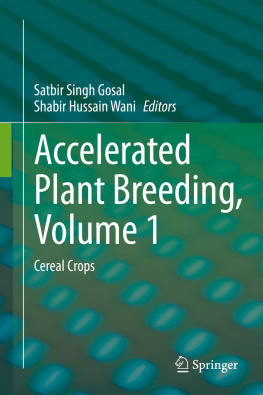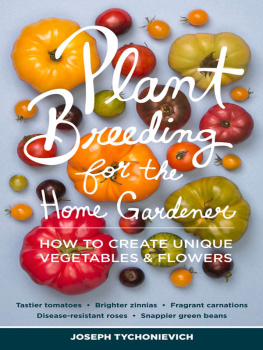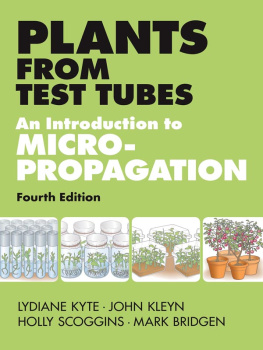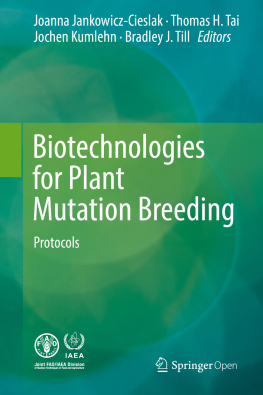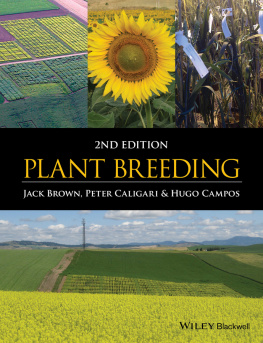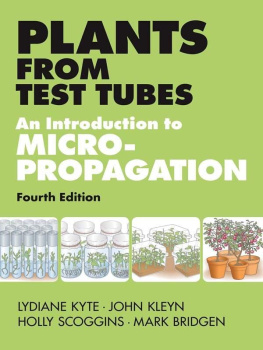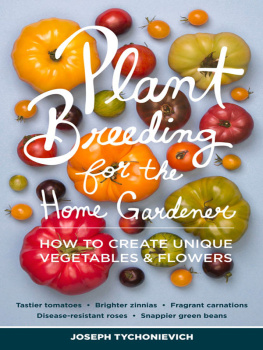Dictionary of Plant Breeding
Dictionary of Plant Breeding
Third Edition
Rolf H. J. Schlegel

CRC Press
Taylor & Francis Group
6000 Broken Sound Parkway NW,
Suite 300, Boca Raton, FL 33487
2020 by Taylor & Francis Group, LLC
CRC Press is an imprint of Taylor & Francis Group, an Informa business
No claim to original U.S. Government works
Printed on acid-free paper
International Standard Book Number-13: 978-0-367-49216-8 (Hardback)
This book contains information obtained from authentic and highly regarded sources. Reasonable efforts have been made to publish reliable data and information, but the author and publisher cannot assume responsibility for the validity of all materials or the consequences of their use. The authors and publishers have attempted to trace the copyright holders of all material reproduced in this publication and apologize to copyright holders if permission to publish in this form has not been obtained. If any copyright material has not been acknowledged please write and let us know so we may rectify in any future reprint.
Except as permitted under U.S. Copyright Law, no part of this book may be reprinted, reproduced, transmitted, or utilized in any form by any electronic, mechanical, or other means, now known or hereafter invented, including photocopying, microfilming, and recording, or in any information storage or retrieval system, without written permission from the publishers.
For permission to photocopy or use material electronically from this work, please access www.copyright.com (http://www.copyright.com/) or contact the Copyright Clearance Center, Inc. (CCC), 222 Rosewood Drive, Danvers, MA 01923, 978-750-8400. CCC is a not-for-profit organization that provides licenses and registration for a variety of users. For organizations that have been granted a photocopy license by the CCC, a separate system of payment has been arranged.
Trademark Notice : Product or corporate names may be trademarks or registered trademarks, and are used only for identification and explanation without intent to infringe.
Visit the Taylor & Francis Web site at
http://www.taylorandfrancis.com
and the CRC Press Web site at
http://www.crcpress.com
Contents
Modern plant breeding has improved the livelihoods of hundreds of millions of people in the world. Plant breeding began in Neolithic times, when the people collected and later sowed seed of plants they liked. But it was not until the encounter with Mendels discoveries thousands of years later that the genetic basis of breeding was understood. Developments since then have provided further insight into how genes acting alone, or in concert with other genes and the environment, result in a particular phenotype.
As a complex subject, plant breeding makes use of many scientific and technological disciplines, such as agronomy, horticulture, forestry, seed production, genetics, molecular genetics, biotechnology, biochemistry, mutagenesis, population genetics, biometry, botany, cytology, cytogenetics, ecology, plant evolution or genetic conservation, and laboratory technologies. Often it is difficult to know the precise meaning of many terms and to accurately interpret specific concepts of plant breeding. Most dictionaries and glossaries available are highly specific or fragmentary. Until now, no attempt has been made to provide a comprehensive compilation of plant breeding terms. This dictionary includes the specific terms of plant breeding and terms that are adjusted from other disciplines.
Moreover, the intent was to create a book that includes not only present terms, but also some terms used during the long history of plant breeding. In addition, this book offers most of the words used by a plant breeder and seed producer together in one source. In order to also serve students, teachers, and research workers, the book is supplemented with breeding schemes, tables, examples, and a list of crop plants, including a few details.
Completeness could not be achieved. The modern subjects, such as biotechnology, molecular genetics, cytogenetics, and genetic engineering, were included as far as possible. Selection was made on the basis of the authors experience and his knowledge of the breeders requirements. This is a modest effort to serve the scientific community.
Plant breeding is a rapidly developing subject. The recent integration of advances in biotechnology, genomic research, and molecular marker applications with conventional plant breeding practices has created the foundation for molecular plant breeding, an interdisciplinary science that is revolutionizing 21st-century crop improvement. Techniques such as cutting and modifying the genome during the repair process by zinc finger nuclease; TALENs, and CRISPR/Cas, genome editing to introduce changes to just a few base pairs (by oligonucleotide-directed mutagenesis), transferring genes from an identical or closely related species (by cisgenesis), adding in a reshuffled set of regulatory instructions from same species (by intragenesis), deploying processes that alter gene activity without altering the DNA itself (by epigenetic methods), or grafting of unaltered plant onto a genetically modified rootstock are considered in this edition.
Therefore, the definitions or descriptions given here may subsequently be modified. The author, therefore, accepts no responsibility for the legal validity, accuracy, adequacy, or interpretation of the terms given in this book. Suggestions or errors brought to his attention will be considered whenever possible.
This third edition of the dictionary has again undergone extensive revision and supplements since the first and second successful publications in 2003 as well as 2010, respectively. A good handbook is never completed! It provides an update on the research worldwide. In addition, several new technical terms are included, including improvement as well as supplements of descriptions. This totally revised and expanded reference provides comprehensive coverage of the latest discoveries in cytogenetics, molecular genetics, marker-assisted selection, experimental gene transfer, seed sciences, crop physiology, and genetically modified crops.
The book offers an encyclopedic list of nearly 10,000 contemporary references, over 40% more than the second edition, and over 50 useful tables and 65 drawings and/or figures. The third edition is an up-to-date resource for plant and crop physiologists; plant, crop, soil, and environmental scientists; botanists; agronomists; agriculturists; horticulturists; biochemists; foresters; plant culturists; and upper-level undergraduate and graduate students in these disciplines.
Rolf H. J. Schlegel , Ph.D. , is Professor of Cytogenetics and Applied Genetics, with over 50 years of experience in research and teaching of advanced genetics and plant breeding in Germany and Bulgaria. Prof. Schlegel is the author of more than 160 research papers, monographs, and scientific contributions, co-coordinator of international research projects, and has been a scientific consultant at the Bulgarian Academy of Agricultural Sciences for several years. He received his Masters degree in Agriculture and Plant Breeding, and his Ph.D. and D.Sc. in Genetics and Cytogenetics from the Martin-Luther University Halle/S., Germany. Later he became Head of Laboratory of Chromosome Manipulation and the Department of Applied Genetics and Genetic Resources at the Institute of Plant Genetics and Crop Plant Research, Gatersleben, Germany, and the Head of the Genebank at the Institute of Wheat and Sunflower Research, General Toshevo/Varna, as well as at the AgroBioInstitute, Sofia, Bulgaria. He is now emeritus of the institute.



